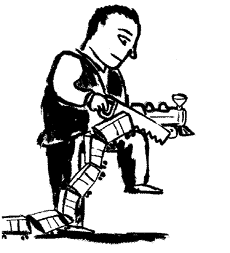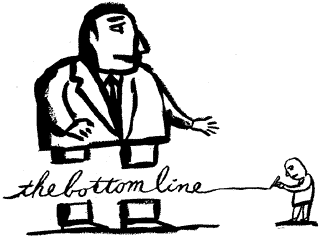The Downside of Downsizing
You can't pay the bills or track the trains if your workers are exhausted.

Somewhere along the Gulf coast a railroad car is lost. Actually, somewhere along the Gulf coast many railroad cars are lost, rolling along between freight yards, attached to locomotives they're not supposed to be attached to, carrying goods that will arrive at their intended destinations days or even weeks late. The cars belong to the Union Pacific Corp. In the 19th century, Union Pacific built the railroad that joined the nation. In the past few months, though, it's had its hands full trying to make the trains run on time.
Aetna, meanwhile, is having a very hard time making sure that its clients' claims get paid. Unpaid claims have been piling up in its back offices, and last month the insurance company announced that its third-quarter earnings had fallen significantly because of all the administrative problems. Medical costs, at least at the health-care providers with whom Aetna deals, have been rising, but since Aetna wasn't paying its bills, it wasn't able to figure that out until recently.
On the surface, these might seem to be two unconnected stories of corporate miscalculation. But you don't have to look too deeply beneath the surface to recognize that the problems Union Pacific and Aetna are facing stem from the same cause, namely overhasty and overaggressive job cutting, and that together they represent what you might call the downside of downsizing.
Both Union Pacific and Aetna have consummated large-scale mergers in the past year and a half, and both are therefore attempting to deal with sizable increases in their everyday business. Union Pacific, which has spent much of the past decade acquiring smaller rail companies, bought Southern Pacific for $3.9 billion, adding 15,000 miles of track to its inventory. Aetna, meanwhile, shelled out $9 billion to buy U.S. Healthcare in April of 1996, which left it with more than 11 million people in its various health-care plans. One might have imagined that, in the face of a larger client base and the difficult task of integrating two separate corporate organizations, computer systems, and cultures, slashing payrolls would not have been Job 1. But then one would, of course, have imagined wrongly.
Aetna waited six months after its acquisition of U.S. Healthcare to announce that it was cutting 4,400 jobs and consolidating its 44 national service centers into 12 regional centers. The stock market, needless to say, applauded the decision. As one analyst put it, "Any time you have an organization that pays close to $9 billion for a company that others wouldn't have paid nearly as much for, it's natural that they're going to look for substantial cost reductions to justify the transaction." Union Pacific's job cuts were smaller--more than 1,000 employees were offered buyouts. But they were even more dubious strategically, since the rail-freight business was booming nationally, and losing Southern Pacific managers and engineers meant that UP now had thousands of miles of new track and very few workers who had any experience with it.

In retrospect, the results of these job cuts seem predictable. Aetna discovered that, in the words of its president, "We miscalculated how valuable the experience level was, and is, in the staff that works in these service centers." The company is now hiring back a hundred or so claims agents to speed up processing, but it remains unclear how much long-term damage was done, in terms of alienated clients and health-care providers and of the months that Aetna has spent essentially flying blind. What's more, the company's stock price has tumbled sharply.
The consequences of Union Pacific's problems have been rather more severe. Since June, the company has had five serious accidents--including two in the last two weeks--that have taken seven lives and caused millions of dollars in damage. A month ago, Federal Railroad Administration officials sprang surprise inspections on Union Pacific in 11 cities. They found overworked crews, with engineers, brakemen, and dispatchers turning in 80-hour weeks, working six or seven days in a row. Regulators called UP's safety record "a fundamental breakdown," and things have not improved since then. Last Friday, the Surface Transportation Board declared "a transportation emergency in the West," while the FRA announced that it would step up its monitoring of crew fatigue and track safety.
Oddly, the FRA has yet to come up with a firm policy to solve the crew-fatigue problem, though it has promised to produce one within 30 days. Thirty days? How long does it take to say, "Um, we think you have to hire more people right now"? Union Pacific has, in fact, announced that it will be adding 1,500 new workers, but analysts estimate that the crisis has already cost shippers more than $1 billion in delayed shipments and delivery snafus. UP President Jerry Davis has said he wanted to have "the right number of people" running the railroad, since "it's a safety issue, not a financial issue." But one suspects that we got something closer to the truth when, in the midst of the crisis, a UP spokesman said, "Nobody's budget is safe when it comes to doing more with less." Didn't anyone tell him he worked in public relations?
What both the Aetna and Union Pacific stories illuminate is the degree to which downsizing has become simply a reflex decision for many managers. The stock market's instinctively positive reaction to job cuts surely makes it easier for managers to justify their decisions to themselves. But the reality is that job cuts have more to do with an ill-considered definition of the bottom line than with placating Wall Street. In other words, it's easier to look at the reduced labor costs from cutting 4,400 jobs than to anticipate the potential chaos those cuts will bring. And that's particularly true when the concept of the lean and mean corporation has attained the status of dogma. In his A Passion forExcellence, the sequel to In Search of Excellence, still an enormously influential business book, Tom Peters wrote, "There is, then, a lot that can be said for simply cutting staff. We find so many companies that do so much better with so many fewer people." Perhaps Peters can issue a revised edition, with chapters on Union Pacific and Aetna.
The point is not that downsizing is in and of itself a mistake. The fact that industries wax and wane is a reality of any economic system that wants to remain dynamic and responsive to people's changing tastes. Jobs lost in one place are often created in another (although there are serious questions about whether the jobs will be as good, particularly for industrial workers). And a number of large firms have downsized successfully, most obviously General Electric, which cut an astounding 170,000 jobs worldwide in 12 years while simultaneously tripling its sales.
But too often downsizing means what it has in the Union Pacific case: fewer people doing more work. American workers now pull more overtime than they did in the 1980s, and more companies have embraced required overtime as a way of ensuring that work gets done. In theory, downsizing should be a way of matching the size of your work force to the size of your business. In practice, downsizing is too often about cutting your work force while keeping your business the same, and doing so not by investments in productivity-enhancing technology, but by making people pull 80-hour weeks and bringing in temps to fill the gap. Downsizing itself is an inevitable part of any creatively destructive economy. But overworked engineers and sleepy dispatchers aren't creative, they're simply destructive.